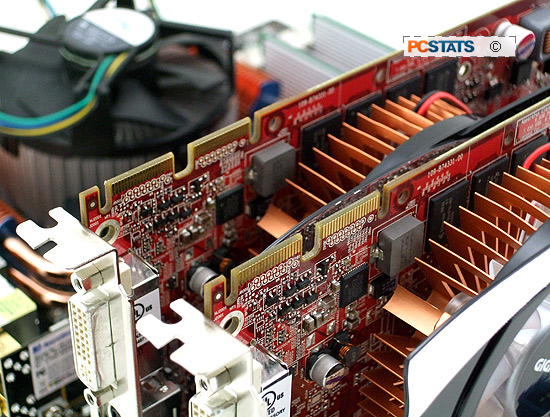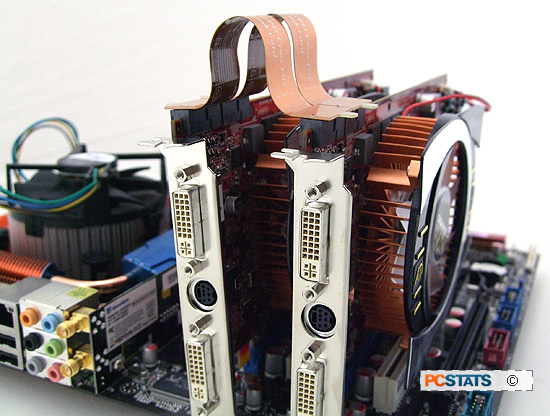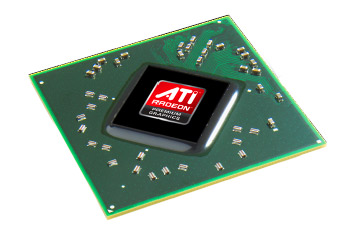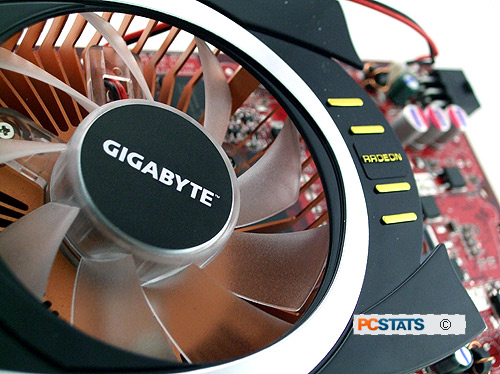
|
ATI's Radeon HD 4770 (code name RV740) is derived from the venerable Radeon RV770 GPU. The Gigabyte GV-R477D5-512H-B videocard has its GPU clocked at 750MHz and is equipped with 512MB GDDR5
memory running at 800MHz, giving it a bandwidth of 51.2 GB/s.
83% Rating: 
|
|
|
|
Home >
Reviews >
Video Cards >
Gigabyte GV-R477D5-512H-B |
|
|
Crossfire'd HD4770's - Twice the Value?
Going Crossfire is pretty simple for most users running Windows Vista
or XP and using Intel or AMD motherboard chipsets. Pretty much every AMD chipset,
including those based on the 780G, 790GX and 790FX chipsets can Crossfire so long as
the motherboard has at least two PCI Express x16 videocard
slots. Intel's popular P35, P45, X38 and X48 chipsets can also be configured for Crossfire mode, again, as long as
there is more than one PCI Express x16 slot available on the
motherboard.
|

Teaming two Radeon HD 4770s together in
Crossfire X mode can be done by using the Crossfire bridge connectors on
both video cards.
|
Setting up and enabling Crossfire is as easy as installing the videocards
into the PCI Express x16 motherboard slots and connecting them with Crossfire bridge
connectors (usually included with the motherboard, check the box). Then all you have
to do is install the AMD Catalyst control center, hit the 'enable Crossfire
X' option and you should be able to enjoy dual-GPU processing - simple!
|

The Radeon HD 4770 videocard can be used in Crossfire mode on
most Intel and AMD chipsets that have dual x16 PCI Express
slots.
|
Built for Mainstream Gaming - Radeon HD 4770 Technology
Most significantly, the Radeon HD 4770 'RV740' GPU is
manufactured on the 40nm process, making it the first GPU from NVIDIA or ATI to
be made with this process technology.  The GPU
itself contains 826 million transistors, and total board power sits around
80W. Smaller manufacturing processes improve power efficiency and to some extent allows the GPU to be
clocked higher without the lock-step increase in heat. Another benefit is that videocard manufacturers can
produce more GPUs from the same silicon wafer, which lowers production costs and
keeps the videocard affordable.
The GPU
itself contains 826 million transistors, and total board power sits around
80W. Smaller manufacturing processes improve power efficiency and to some extent allows the GPU to be
clocked higher without the lock-step increase in heat. Another benefit is that videocard manufacturers can
produce more GPUs from the same silicon wafer, which lowers production costs and
keeps the videocard affordable.
To really understand where the new ATI Radeon HD 4770 (RV740) graphics card
fit in, it's best to compare it directly against several existing
mainstream videocards. For although the new RV740 GPU is a direct descendent of
the RV770 from AMD's flagship Radeon HD 4870 and 4870 X2 graphics cards, much of
the original card's complex microarchitecture has been stripped down.
While the model numbers indicate that the Radeon HD 4770 is a series "below"
the Radeon HD 4850, the RV740 GPU is clocked at 750MHz, compared to 625MHz for
the Radeon HD 4850. The new Radeon HD 4770 is paired with GDDR5 memory operating
at 800MHz (effective speed: 3200MHz), so it has a higher data rate than the
GDDR3 RAM used with Radeon HD 4850 cards.
|
Videocard
Comparison Chart
|
|
AMD
Radeon HD 4550 |
AMD Radeon HD
4770 |
AMD Radeon HD
4830 |
AMD Radeon HD
4850 |
NVIDIA Geforce GTS
250 |
| GPU Code Name: |
RV710 |
RV740 |
RV770 |
RV770 |
G92+ |
| GPU Process: |
55nm |
40nm |
55nm |
55nm |
55nm |
| GPU Transistors: |
242 Million |
826
Million |
956 Million |
956 Million |
754 Million |
| Board Power: |
25W |
80W |
110W |
110W |
150W |
| GPU Core Clock Speed: |
600MHz |
750MHz |
575MHz |
625MHz |
738MHz |
| Memory Speed: |
800MHz(1600MHz GDDR3) |
800MHz(3200MHz GDDR5) |
900MHz(1800MHz DDR) |
993MHz(1986MHz DDR) |
1100MHz(2200 DDR) |
| Memory Capacity: |
256MB |
512MB GDDR5 |
512MB GDDR3 |
512MB GDDR3
|
512MB GDDR3 |
| Memory bandwidth: |
12.8 GB/S |
51.2 GB/S |
57.6 GB/S |
63.5
GB/S |
70.4 GB/S |
| Stream Processors: |
80 |
640 |
640 |
800 |
128 |
| Texture units: |
8 |
32 |
32 |
40 |
64 |
| Raster Operators: |
4 |
16 |
16 |
16 |
16 |
| GFLOPS: |
96 |
960 |
736 |
1000 |
470 | | |
However the Radeon 4850 GPU still has more robust
architecture; 800 stream processors and a 40 texture units compared to the HD
4770 which has 640 stream processors and 32 texture units. Even the Radeon HD
4770's use of GDDR5 memory doesn't make it a clear winner on specs alone, since
it's limited to a 128-bit wide memory bus, whereas the Radeon HD 4850 GDDR3
memory uses a 256-bit wide memory bus.
What all this means is that the RV740 GPU isn't quite as
smart as the RV770 or NVIDIA's G92+, but it's not too far off.
 The HD 4850 has more stream processors than
the HD 4770 (800 vs 640), while the GTS250 makes use of more texture units and
vertex pipelines, which turns into greater shader processing and geometry
rendering power. The HD 4850 has more stream processors than
the HD 4770 (800 vs 640), while the GTS250 makes use of more texture units and
vertex pipelines, which turns into greater shader processing and geometry
rendering power.
This means that games that feature complex special effects like distortion,
HDR lighting or reflections, or in games with especially complex geometry, the
Radeon HD 4770 won't get quite as much done each rendering pass, although it
does boast compute performance of 960GFLOPs.
Altogether the new Radeon HD 4770 being unleashed today
will likely process less shader information in a single pass than the Radeon HD
4850, but compensate for that by running through each pass more quickly. This
should translate to very close benchmark results between the two cards in
shader-intensive games like Crysis, but there's no need to speculate.
There are a pair of Radeon
HD 4770 videocards sitting on the PCSTATS test bench right now, let's see how they fare against
high-end videocards in the power draw test next!
|
